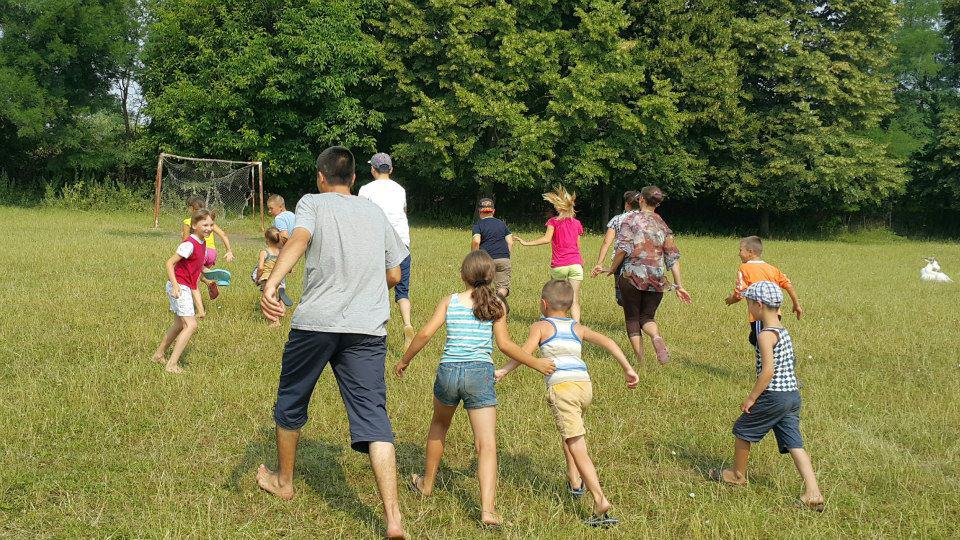Because this week the students of the International Mission School “Precept Ministries Eurasia” organize camps for children in 11 localities, I found it appropriate to write this article. Here I want to describe 10 games that I find interesting and effective for day camps.
The snake’s tail
The players are divided into 2 teams. They all sit in a column, holding on to the one in front. A “tail” (ribbon) is attached to the last player. The team’s goal is to catch the opponent’s tail while keeping their own. Only the one in front can take the tail.
Islands
Newspapers are set up on the ground. The children run all over the field. At the signal of the leader, all children must go to the newspaper “islands” and accommodate as many as possible. If a child has a foot “in the sea,” he leaves the game.As the game progresses, the leader takes newspapers out of the game.
Mess
All the children hold hands and form a circle. A player must leave or turn around in such a way that he does not see what all the players are doing. The ones in the circle, holding hands, mix by passing under the hands of other children and create a knot. The one who went out must come and “untie” them. Then the next player is chosen.
Capture the flag
Players must be divided into 2 teams. The land is marked and divided into two. At the end of each field, a circle is marked, in the middle of which a flag or a ball is placed. The goal of the team is to go to the opponent’s field and bring their flag to its field. Only one person on the team is allowed to guard the flag. When a player is on the opponent’s court, the home team is allowed to freeze him. Those who are frozen can be thawed when a teammate touches them with his hand.
Break the balloon
A balloon is tied to each participant. The goal of the game is for everyone to break the others’ balloons, but at the same time to take care of his own.
Chocolate
For this game you need a chocolate, a table knife, a fork, a hat, gloves, a scarf, and dice. All participants sit around the table. All objects are placed on the table. Each participant rolls the dice one by one. If the dice number is “1” then he is allowed to wear a scarf, a hat and gloves, then open the chocolate and cut it with a knife and eat it with a fork. In the meantime, the rest of the players continue to roll the dice until someone else rolls number “1.” Usually, by the time you get dressed, it’s already another person’s turn to eat the chocolate.
Momentum
All participants are divided into 2 equal teams. They form a chain and the first player on each team holds hands with the leader. An object is arranged at the end of the rows. The object can be a pencil, a toy, a bottle, anything. The leader transmits the impulse to the team by squeezing hands, to both teams at the same time. The last player in each chain, when he receives the impulse, must take the object. The team that takes the object first wins.
Double
For this game you need a pen, sheets for all participants and 2 dice. The pen is arranged in the middle of the table, and the participants sit around the table. In turn, each player rolls the dice. Whoever rolls doubles (eg 1-1, 2-2, 3-3, 4-4, 5-5, 6-6) takes the pen and starts writing 1, 2, 3, 4… 100. In the meantime, the rest of the players continue to roll the dice and whoever rolls doubles, takes the pen from the writer and starts writing. The winner is the one who reaches 100 first.
Relays
All participants are divided into several teams of 10-15 participants. An equal distance is established that they will have to cover. There are a variety of conditions for this game — you can organize it with water, with a ball, without a ball, with bags, with balloons. Here are some examples. The children have to run quickly and there are balloons on the other side. The player must take the balloon, inflate it and sit on it to pop it, then quickly run back to the team. Another way is that he has to bring the balloon with a stick (like hockey). In the image below you see a game with newspapers. Each team is given 2 newspapers and they have to cover the distance with newspapers.
Butterfly (Летучий голландец)
All players sit in a circle, holding hands. Two players run around the circle. They need to touch a “wrist” and then run faster. That “pair” that has been chosen must run in the opposite direction from the pair that chose them. The pair that reaches the starting place first wins, and the one that fails chooses the next “wrists.”
I hope that these ideas will be useful to you and that you will be able to serve the children so that they may come to know God. Those who want to learn more about how to work with children are welcome to the training sessions for Sunday school teachers where they can study more deeply how you can work effectively with children.
Translated by Liza Birladeanu


